
Isbladskärret
Encyclopedia
Isbladskärret is a small lake
on Djurgården, an island in central Stockholm
, Sweden
. The lake is much appreciated among bird-watchers, and, being part of the National park in central Stockholm, Ekoparken
, also carefully monitored by several organizations, including the World Wide Fund for Nature
. The lake is one of six on Djurgården, the others being Lillsjön
, Uggleviken
, Spegeldammen
, Lappkärret
, and Laduviken.
 The name is derived from a small hunter's lodge located near the present lake. In historical records documenting fishing grounds on Djurgården during the 17th century, the lodge is unintelligibly called Isbla. The same lodge also gave name to a bay, Isbladsviken. Most Stockholmer's today are likely to interpret the name as Is-blads-kärret ("The Ice Leaf Marsh")or (the one that kills) we are unsure of the real name.
The name is derived from a small hunter's lodge located near the present lake. In historical records documenting fishing grounds on Djurgården during the 17th century, the lodge is unintelligibly called Isbla. The same lodge also gave name to a bay, Isbladsviken. Most Stockholmer's today are likely to interpret the name as Is-blads-kärret ("The Ice Leaf Marsh")or (the one that kills) we are unsure of the real name.
separating the northern and southern parts of Djurgården until the 1830s when the canal Djurgårdsbrunnskanalen
was built. By the turn of the century 1900, Prince Carl
(1861–1951) settle at Parkudden nearby and had the swamp drained. The surrounding area was then used for agriculture until the 1950s, but the pumping-station remained in use until the Royal Djurgården Administration decided to develop the area in 1981 to attracts birds and plant life and closed to pump. Within a year sea birds had found the lake and more than 70 species have been spotted by the lake since, as a sign in the northern end of the lake knowns to tell. Footpaths and outlooks have been created around the lake since.

_stockholm_sweden_20050812.jpg) The large number of bird species have made the lake and the surrounding area popular among Stockholmers and tourists alike. The lake area is mostly famous for its colony of more than 100 heron
The large number of bird species have made the lake and the surrounding area popular among Stockholmers and tourists alike. The lake area is mostly famous for its colony of more than 100 heron
s (all originating from birds that once escaped from the zoo at Skansen
), but the surrounding walks in the forests are also known for the Tawny Owl
found there.
Bird species with an annual presences by the lake include: Great crested grebe
, Slavonian Grebe
, Black-headed Gull
, Tufted Duck
, Gadwall
, Northern Shoveler
, Wigeon
, Eurasian Coot
, Common Moorhen
, Common Goldeneye
, Ardea
, Greylag Goose
, Canada Goose
, Barnacle Goose
, Wood Warbler
, European Pied Flycatcher
, Thrush Nightingale
, Eurasian Nuthatch
, Common Treecreeper
, European Robin
, Hawfinch
, Willow Warbler
s, Whitethroat
, Chaffinch
, Blue Tit
, European Goldfinch
, Great Spotted Woodpecker
, Dunlin
, Greenshank
, Northern Lapwing
, Ruff, and European Green Woodpecker. Less common are Icterine Warbler
, Marsh Warbler
, Sedge Warbler
, Winter Wren
, and Lesser Spotted Woodpecker
.
Lake
A lake is a body of relatively still fresh or salt water of considerable size, localized in a basin, that is surrounded by land. Lakes are inland and not part of the ocean and therefore are distinct from lagoons, and are larger and deeper than ponds. Lakes can be contrasted with rivers or streams,...
on Djurgården, an island in central Stockholm
Stockholm
Stockholm is the capital and the largest city of Sweden and constitutes the most populated urban area in Scandinavia. Stockholm is the most populous city in Sweden, with a population of 851,155 in the municipality , 1.37 million in the urban area , and around 2.1 million in the metropolitan area...
, Sweden
Sweden
Sweden , officially the Kingdom of Sweden , is a Nordic country on the Scandinavian Peninsula in Northern Europe. Sweden borders with Norway and Finland and is connected to Denmark by a bridge-tunnel across the Öresund....
. The lake is much appreciated among bird-watchers, and, being part of the National park in central Stockholm, Ekoparken
Ekoparken
The Royal National City Park is the world's first National City Park, established in 1995 in the municipalities of Stockholm, Solna and Lidingö in Sweden.1/ km²2/ Population per km²- Pictures :Some places in "The Eco Park"....
, also carefully monitored by several organizations, including the World Wide Fund for Nature
World Wide Fund for Nature
The World Wide Fund for Nature is an international non-governmental organization working on issues regarding the conservation, research and restoration of the environment, formerly named the World Wildlife Fund, which remains its official name in Canada and the United States...
. The lake is one of six on Djurgården, the others being Lillsjön
Lillsjön, Djurgården
Lillsjön is a small, former lake at Norra Djurgården, a rural area in north-eastern central Stockholm, Sweden, forming part of the national city park Ekoparken...
, Uggleviken
Uggleviken
Uggleviken is a former bay and lake at Norra Djurgården, a rural area in north-eastern central Stockholm, Sweden, forming part of the national city park Ekoparken....
, Spegeldammen
Spegeldammen
Spegeldammen is a small lake at Norra Djurgården in north-eastern central Stockholm, Sweden. It is one of six lakes in Djurgården, the others being Lillsjön, Uggleviken, Isbladskärret, Laduviken, and Lappkärret....
, Lappkärret
Lappkärret
Lappkärret is a small lake at Norra Djurgården in north-eastern central Stockholm, Sweden. It is one of six lakes in Djurgården, the others being: Lillsjön, Uggleviken, Isbladskärret, Laduviken, and Spegeldammen....
, and Laduviken.
Origin of the name

History
The area was originally a marshMarsh
In geography, a marsh, or morass, is a type of wetland that is subject to frequent or continuous flood. Typically the water is shallow and features grasses, rushes, reeds, typhas, sedges, other herbaceous plants, and moss....
separating the northern and southern parts of Djurgården until the 1830s when the canal Djurgårdsbrunnskanalen
Djurgårdsbrunnskanalen
Djurgårdsbrunnskanalen is a canal in central Stockholm, Sweden, separating the island Djurgården from the northern mainland ....
was built. By the turn of the century 1900, Prince Carl
Prince Carl, Duke of Västergötland
Prince Carl of Sweden and Norway, Duke of Västergötland , was the third son of King Oscar II of Sweden-Norway and Sophia of Nassau.-History:...
(1861–1951) settle at Parkudden nearby and had the swamp drained. The surrounding area was then used for agriculture until the 1950s, but the pumping-station remained in use until the Royal Djurgården Administration decided to develop the area in 1981 to attracts birds and plant life and closed to pump. Within a year sea birds had found the lake and more than 70 species have been spotted by the lake since, as a sign in the northern end of the lake knowns to tell. Footpaths and outlooks have been created around the lake since.
Birds

_stockholm_sweden_20050812.jpg)
Heron
The herons are long-legged freshwater and coastal birds in the family Ardeidae. There are 64 recognised species in this family. Some are called "egrets" or "bitterns" instead of "heron"....
s (all originating from birds that once escaped from the zoo at Skansen
Skansen
Skansen is the first open air museum and zoo in Sweden and is located on the island Djurgården in Stockholm, Sweden. It was founded in 1891 by Artur Hazelius to show the way of life in the different parts of Sweden before the industrial era....
), but the surrounding walks in the forests are also known for the Tawny Owl
Tawny Owl
The Tawny Owl or Brown Owl is a stocky, medium-sized owl commonly found in woodlands across much of Eurasia. Its underparts are pale with dark streaks, and the upperparts are either brown or grey. Several of the eleven recognised subspecies have both variants...
found there.
Bird species with an annual presences by the lake include: Great crested grebe
Great Crested Grebe
The Great Crested Grebe is a member of the grebe family of water birds.- Description :The Great Crested Grebe is long with a wingspan. It is an excellent swimmer and diver, and pursues its fish prey underwater. The adults are unmistakable in summer with head and neck decorations...
, Slavonian Grebe
Slavonian Grebe
The Horned Grebe or Slavonian Grebe, Podiceps auritus, is a member of the grebe family of water birds. The Slavonian Grebe is an excellent swimmer and diver, and pursues its fish prey underwater...
, Black-headed Gull
Black-headed Gull
The Black-headed Gull is a small gull which breeds in much of Europe and Asia, and also in coastal eastern Canada. Most of the population is migratory, wintering further south, but some birds in the milder westernmost areas of Europe are resident...
, Tufted Duck
Tufted Duck
The Tufted Duck, Aythya fuligula, is a medium-sized diving duck with a population of close to one million birds.- Description :The adult male is all black except for white flanks and a blue-grey bill. It has an obvious head tuft that gives the species its name.The adult female is brown with paler...
, Gadwall
Gadwall
The Gadwall is a common and widespread duck of the family Anatidae.- Description :The Gadwall is 46–56 cm long with a 78–90 cm wingspan. The male is slightly larger than the female, weighing on average 990 g against her 850 g...
, Northern Shoveler
Northern Shoveler
The Northern Shoveler , Northern Shoveller in British English, sometimes known simply as the Shoveler, is a common and widespread duck. It breeds in northern areas of Europe and Asia and across most of North America, and is a rare vagrant to Australia...
, Wigeon
Wigeon
The Eurasian Wigeon, also known as Widgeon or Eurasian Widgeon is one of three species of wigeon in the dabbling duck genus Anas. It is common and widespread within its range...
, Eurasian Coot
Eurasian Coot
The Eurasian Coot, Fulica atra, also known as Coot, is a member of the rail and crake bird family, the Rallidae. The Australian subspecies is known as the Australian Coot.-Distribution:...
, Common Moorhen
Common Moorhen
The Common Moorhen is a bird in the Rallidae family with an almost worldwide distribution. The North and South American Committees of the AOU and the IOC have voted on or before July 2011 to split the American forms into a new species Common Gallinule, however, no other committee has voted to...
, Common Goldeneye
Common Goldeneye
The Common Goldeneye is a medium-sized sea duck of the genus Bucephala, the goldeneyes. Their closest relative is the similar Barrow's Goldeneye....
, Ardea
Ardea (genus)
Ardea is a genus of herons. Linnaeus named this genus as the Great Herons, referring to the generally large size of these birds, typically 80–100 cm or more in length....
, Greylag Goose
Greylag Goose
The Greylag Goose , Anser anser, is a bird with a wide range in the Old World. It is the type species of the genus Anser....
, Canada Goose
Canada Goose
The Canada Goose is a wild goose belonging to the genus Branta, which is native to arctic and temperate regions of North America, having a black head and neck, white patches on the face, and a brownish-gray body....
, Barnacle Goose
Barnacle Goose
The Barnacle Goose belongs to the genus Branta of black geese, which contains species with largely black plumage, distinguishing them from the grey Anser species...
, Wood Warbler
Wood Warbler
The Wood Warbler is a common and widespread leaf warbler which breeds throughout northern and temperate Europe, and just into the extreme west of Asia in the southern Ural Mountains...
, European Pied Flycatcher
European Pied Flycatcher
The Pied Flycatcher, Ficedula hypoleuca, is a small passerine bird in the Old World flycatcher family, one of the four species of Western Palearctic black-and-white flycatchers. It breeds in most of Europe and western Asia. It is migratory, wintering mainly in western Africa. It hybridizes with...
, Thrush Nightingale
Thrush Nightingale
The Thrush Nightingale, Luscinia luscinia , is a small passerine bird that was formerly classed as a member of the thrush family Turdidae, but is now more generally considered to be an Old World flycatcher, Muscicapidae...
, Eurasian Nuthatch
Eurasian Nuthatch
The Eurasian Nuthatch, Sitta europaea, is a small passerine found throughout temperate Europe and Asia, although not in Ireland. It belongs to the nuthatch family Sittidae....
, Common Treecreeper
Common Treecreeper
The Eurasian Treecreeper or Common Treecreeper is a small passerine bird also known in the British Isles, where it is the only living member of its genus, simply as Treecreeper. It is similar to other treecreepers, and has a curved bill, patterned brown upperparts, whitish underparts, and long...
, European Robin
European Robin
The European Robin , most commonly known in Anglophone Europe simply as the Robin, is a small insectivorous passerine bird that was formerly classed as a member of the thrush family , but is now considered to be an Old World flycatcher...
, Hawfinch
Hawfinch
The Hawfinch, Coccothraustes coccothraustes, is a passerine bird in the finch family Fringillidae. Its closest living relatives are the Evening Grosbeak from North America and the Hooded Grosbeak from Central America especially Mexico.This bird breeds across Europe and temperate Asia...
, Willow Warbler
Willow Warbler
The Willow Warbler is a very common and widespread leaf warbler which breeds throughout northern and temperate Europe and Asia, from Ireland east to the Anadyr River basin in eastern Siberia...
s, Whitethroat
Whitethroat
The Common Whitethroat, Sylvia communis, is a common and widespread typical warbler which breeds throughout Europe and across much of temperate western Asia. This small passerine bird is strongly migratory, and winters in tropical Africa, Arabia and Pakistan.This is one of several Sylvia species...
, Chaffinch
Chaffinch
The Chaffinch , also called by a wide variety of other names, is a small passerine bird in the finch family Fringillidae.- Description :...
, Blue Tit
Blue Tit
The Blue Tit is a 10.5 to 12 cm long passerine bird in the tit family Paridae. It is a widespread and common resident breeder throughout temperate and subarctic Europe and western Asia in deciduous or mixed woodlands...
, European Goldfinch
European Goldfinch
The European Goldfinch or Goldfinch is a small passerine bird in the finch family.-Habitat and range:The goldfinch breeds across Europe, North Africa, and western and central Asia, in open, partially wooded lowlands. It is resident in the milder west of its range, but migrates from colder regions...
, Great Spotted Woodpecker
Great Spotted Woodpecker
The Great Spotted Woodpecker , Dendrocopos major, is a bird species of the woodpecker family . It is distributed throughout Europe and northern Asia, and usually resident year-round except in the colder parts of its range...
, Dunlin
Dunlin
The Dunlin, Calidris alpina, is a small wader, sometimes separated with the other "stints" in Erolia. It is a circumpolar breeder in Arctic or subarctic regions. Birds that breed in northern Europe and Asia are long-distance migrants, wintering south to Africa, southeast Asia and the Middle East...
, Greenshank
Greenshank
The Common Greenshank is a wader in the large family Scolopacidae, the typical waders. Its closest relative is the Greater Yellowlegs, together with which and the Spotted Redshank it forms a close-knit group...
, Northern Lapwing
Northern Lapwing
The Northern Lapwing , also known as the Peewit, Green Plover or just Lapwing, is a bird in the plover family. It is common through temperate Eurasia....
, Ruff, and European Green Woodpecker. Less common are Icterine Warbler
Icterine Warbler
The Icterine Warbler is an Old World warbler in the tree warbler genus Hippolais . It breeds in mainland Europe except the southwest, where it is replaced by its western counterpart, Melodious Warbler. It is migratory, wintering in sub-Saharan Africa...
, Marsh Warbler
Marsh Warbler
The Marsh Warbler, Acrocephalus palustris, is an Old World warbler currently classified in the family Acrocephalidae. It breeds in temperate Europe and western Asia and winters mainly in south east Africa...
, Sedge Warbler
Sedge Warbler
The Sedge Warbler is an Old World warbler in the genus Acrocephalus. It is a medium-sized warbler with a brown, streaked back and wings and a distinct pale supercilium. Sedge Warblers are migratory, crossing the Sahara to get from their European and Asian breeding grounds to spend winter in Africa...
, Winter Wren
Winter Wren
The Winter Wren is a very small North American bird and a member of the mainly New World wren family Troglodytidae. It was once lumped with Troglodytes pacificus of western North America and Troglodytes troglodytes of Eurasia under the name Winter Wren.It breeds in coniferous forests from British...
, and Lesser Spotted Woodpecker
Lesser Spotted Woodpecker
The Lesser Spotted Woodpecker is a member of the woodpecker family Picidae. It is assigned to the genus Dendrocopos ....
.
See also
- Geography of StockholmGeography of StockholmThe City of Stockholm is situated on fourteen islands and on the banks to the archipelago where Lake Mälaren meets the Baltic Sea. The city centre is virtually situated on the water.- Islands and islets :- Lakes and watercourses :...
- Lakes of Sweden
- EkoparkenEkoparkenThe Royal National City Park is the world's first National City Park, established in 1995 in the municipalities of Stockholm, Solna and Lidingö in Sweden.1/ km²2/ Population per km²- Pictures :Some places in "The Eco Park"....

